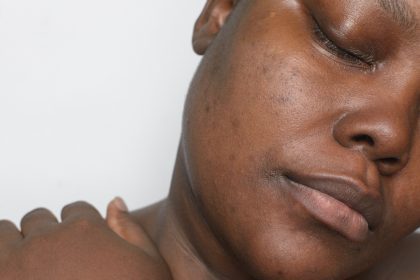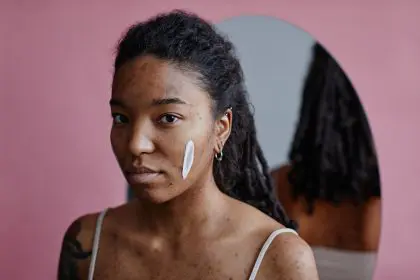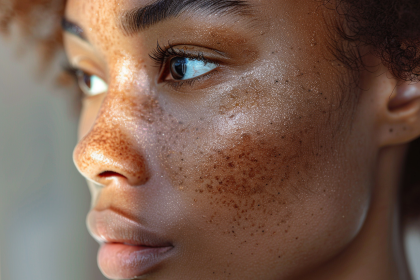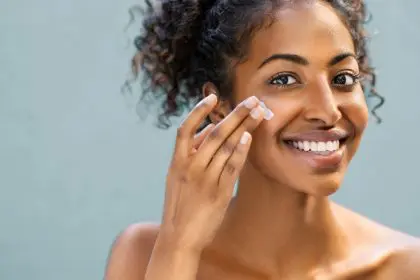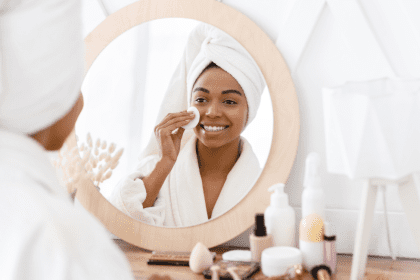You’ve tried everything. The expensive cleansers, the trendy treatments, the disciplined routine. Yet somehow, those frustrating breakouts keep making unwelcome appearances on your face, often in the exact same spots. If you’re trapped in this cycle of clear skin followed by sudden eruptions, you’re not alone. The surprising truth is that the cause of your recurring acne might not be what you think, and the solution could be simpler than you imagined.
The skin cycle you didn’t know about
Your skin operates on its own timeline, regardless of your product-switching desperation. Understanding this natural rhythm explains why acne seems to play a frustrating game of peek-a-boo with your face.
The skin renewal process takes approximately 28 days for the average adult. This means that damage happening below the surface today might not manifest as a visible breakout for nearly a month. Conversely, treatments you start now might not show results until that same cycle completes.
Hormonal fluctuations follow their own reliable patterns. Women often experience breakouts tied to specific points in their menstrual cycle, typically appearing on the jawline and chin about a week before menstruation begins. This cyclic pattern creates the illusion that acne clears and then mysteriously returns.
Seasonal changes affect your skin more than you might realize. Oil production increases during summer months for many people, while winter air can dehydrate skin, triggering compensatory oil production. These predictable annual shifts can make acne seem to disappear and reappear with the seasons.
Stress triggers follow work and life patterns. High-pressure periods at work or school often correlate with breakouts that seem to clear during calmer times, creating a recurring cycle tied to your lifestyle rather than your skincare routine.
This natural cycling explains why acne seems to clear up and then return, even when you’re being consistent with your skincare regimen. It’s not that your treatments stopped working. It’s that your skin is responding to internal timelines beyond your control.
The hidden saboteurs in your daily routine
Some of the most persistent causes of recurring acne hide in plain sight, disguised as innocent parts of your daily life.
Your pillowcase harbors more bacteria than you want to know about. Night after night, it collects facial oils, hair products, dead skin cells, and environmental debris. Then you press your clean face against this petri dish for 7-8 hours. Many dermatologists suggest that changing pillowcases twice weekly can significantly reduce mysterious recurring breakouts.
Cell phones carry more bacteria than toilet seats. Pressing this germ-covered device against your cheek and jawline for long conversations creates a perfect storm of bacteria, pressure, and heat that triggers breakouts in predictable patterns on one or both sides of your face.
Hair products silently migrate onto your skin throughout the day. Those breakouts along your hairline, temples, or forehead often trace back to styling products containing oils and waxes. Even products labeled “non-comedogenic” can cause problems for sensitive skin when left in contact for hours.
Touching your face happens far more often than you realize. Studies show the average person touches their face 16-23 times per hour. This unconscious habit transfers bacteria from everything you’ve touched directly to your skin, often concentrating on specific areas where you rest your hands.
Workout habits create perfect conditions for breakouts. Waiting too long to wash your face after exercising leaves sweat and bacteria to settle into pores. Wearing makeup during workouts compounds the problem, trapping everything under an occlusive layer.
The product problem you don’t suspect
The very products you’re using to fight acne might be contributing to the recurring cycle. This skincare catch-22 frustrates countless acne sufferers.
Product overuse ranks among the most common mistakes. Many acne fighters apply harsh treatments too frequently, damaging the skin barrier. This triggers increased oil production and inflammation, creating a perfect environment for more breakouts just as the previous ones clear.
Ingredient incompatibility occurs when popular acne-fighting ingredients cancel each other out or create irritation when combined. Mixing benzoyl peroxide with retinoids can neutralize both, while layering multiple acids can over-exfoliate the skin. These combinations can trigger a cycle of clear periods followed by angry flare-ups.
Overly harsh cleansers strip your skin’s natural moisture barrier. This protective layer keeps irritants out and moisture in. When damaged by aggressive cleansing, your skin becomes more vulnerable to bacterial invasion and environmental triggers. Plus, it responds to dryness by producing more oil, fueling the acne cycle.
Inconsistent routines prevent any product from working properly. Skincare requires consistent application through multiple skin cycles before showing results. Many people abandon products too quickly or use them sporadically, never giving treatments enough time to break the recurring acne pattern.
Expired or contaminated products breed bacteria right in their containers. That half-used spot treatment from last year might now be doing more harm than good. Skincare products have limited shelf lives once opened, and dipping fingers into jars introduces bacteria with every use.
The invisible internal triggers
While external factors get most of the attention, internal issues often drive recurring acne patterns that seem mysterious from the outside.
Gut health influences skin clarity in ways science is just beginning to understand. The gut-skin axis connects these seemingly unrelated systems. Studies show that gut microbiome imbalances strongly correlate with chronic, recurring acne. Digestive issues that cycle through better and worse periods might explain why your skin follows similar patterns.
Food sensitivities create delayed reactions that make identifying triggers difficult. While the chocolate-causes-acne myth has been debunked, individual sensitivities to dairy, high-glycemic foods, or specific additives can trigger inflammatory responses that manifest as breakouts days later. This delay makes connecting specific foods to breakouts challenging.
Chronic stress alters hormone levels and inflammatory responses throughout the body. The stress hormone cortisol triggers increased oil production when elevated for extended periods. The cycling nature of stress in most people’s lives explains why acne often clears during vacations only to return when regular life resumes.
Sleep quality affects skin repair and hormone regulation. Poor sleep increases inflammatory markers and stress hormones while reducing the skin’s overnight healing processes. Inconsistent sleep patterns might contribute to the cycling nature of your breakouts.
Medication side effects sometimes include acne that appears in cycles. Birth control, corticosteroids, lithium, and other medications can trigger breakouts that seem to come and go without explanation. Even supplements like B vitamins and whey protein can cause problems for some individuals.
The stubborn acne patterns decoded
Different acne patterns offer clues about their underlying causes, helping break the cycle of recurrence.
Forehead and temple breakouts often connect to hair products, bangs that touch the skin, or hats and helmets. This “pomade acne” follows a predictable pattern based on when you use certain products or wear certain headgear.
Cheek acne frequently traces back to phone contact, pillowcases, or touching habits. The placement often shows a dominance on one side matching your phone-holding or sleep position preferences.
Jawline and chin acne has strong hormonal connections, particularly for women. These breakouts often follow hormonal cycles, appearing most prominently during the week before menstruation begins. This pattern can become more pronounced during perimenopause when hormone fluctuations increase.
Mouth and nose border breakouts commonly relate to toothpaste ingredients or lip products. Sodium lauryl sulfate and heavy lip balms can trigger recurring acne in this specific region.
Body acne that accompanies facial breakouts might indicate a systemic trigger like hormones or dietary factors, while isolated body acne often connects to clothing friction, fabric softeners, or delayed showering after workouts.
Breaking the recurring cycle
Ending the frustrating pattern of returning acne requires addressing both the visible symptoms and the root causes driving the cycle.
Simplify before adding. When breakouts return, the instinct to add more products often backfires. Instead, strip your routine down to gentle cleansing, basic moisturizing, and sun protection for two weeks. This reset helps identify whether your products might be contributing to the problem.
Track everything in relation to your breakouts. Keep a simple log noting your cycle, stress levels, diet changes, new products, and when breakouts appear. After a few months, patterns often emerge that reveal triggers you hadn’t suspected.
Consider professional hormone testing if acne consistently recurs in patterns aligned with hormonal fluctuations. Conditions like polycystic ovary syndrome or thyroid issues can drive recurring acne that resists topical treatments.
Address gut health through probiotic foods, fiber-rich vegetables, and reduced sugar intake. Many dermatologists now recommend this approach alongside topical treatments for patients with stubborn recurring acne.
Be patient with new regimens. Given the skin’s renewal cycle, any intervention needs at least one full month to show results, and three months provides a more accurate picture of effectiveness.
Manage stress through whatever method works for you. The skin-stress connection is powerful enough that stress reduction alone sometimes breaks the cycle of returning breakouts, especially for adults with late-onset or persistent acne.
The professional approach to stubborn cycles
When recurring acne resists your best self-care efforts, professional interventions can break the cycle more definitively.
Prescription retinoids like tretinoin normalize the skin cell turnover process that contributes to recurring breakouts. By keeping cells shedding properly, they prevent the clogged pores that start the acne cycle. Unlike over-the-counter options, prescription strengths can address more stubborn cases.
Hormonal treatments including spironolactone or certain birth control formulations help regulate the androgen fluctuations that drive recurring hormonal acne in women. These approaches often succeed where topical treatments fail for cyclical breakouts along the jawline and chin.
Professional extraction by experienced dermatologists or estheticians can sometimes break a recurring cycle by properly clearing impactions that at-home attempts might make worse. This professional clearing gives skin a fresh start.
Light and laser therapies target the bacteria and inflammation driving persistent acne while also addressing the post-inflammatory marks left behind. These treatments can help break cycles by addressing multiple aspects of acne simultaneously.
Dietary intervention under professional guidance helps identify specific triggers through systematic elimination and challenge protocols. This structured approach proves more effective than random elimination attempts for finding food sensitivities driving recurring breakouts.
The recurring nature of acne often signals that surface treatments alone won’t solve the problem. Finding the hidden triggers requires looking deeper at the patterns specific to your life and body. With persistence and the right approach, even the most stubborn acne cycles can be broken, revealing the consistently clear skin you’ve been chasing.



